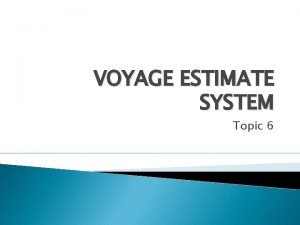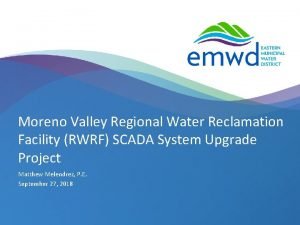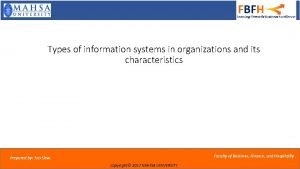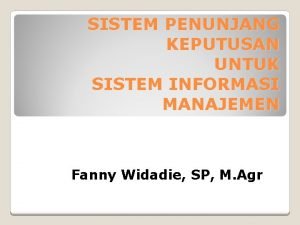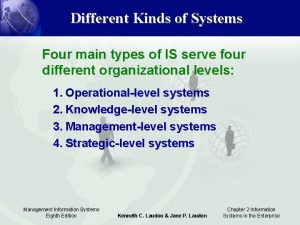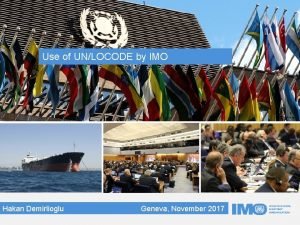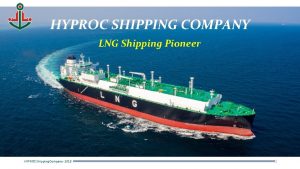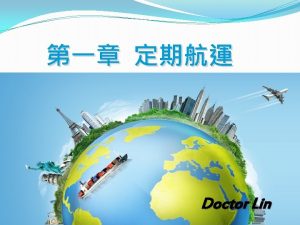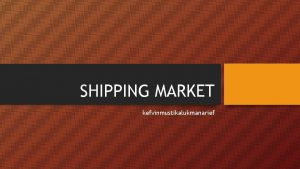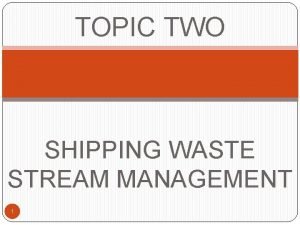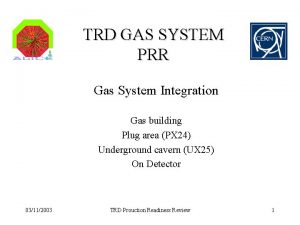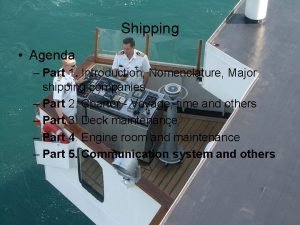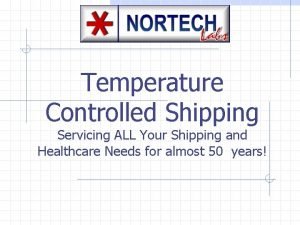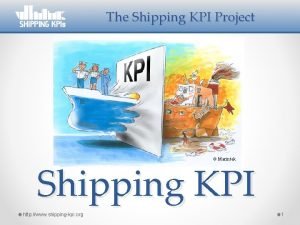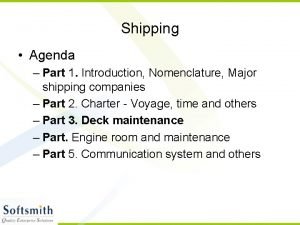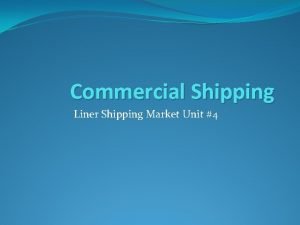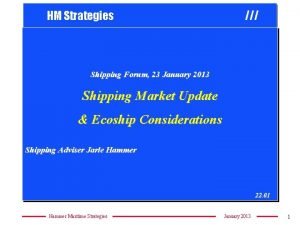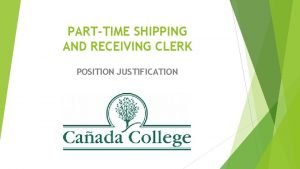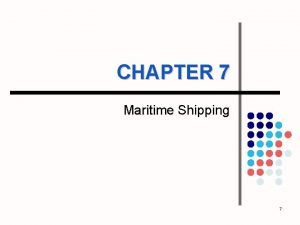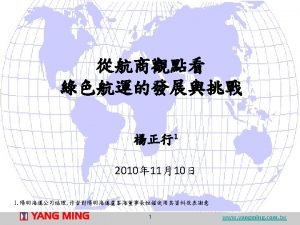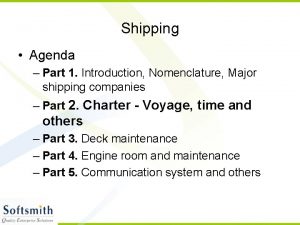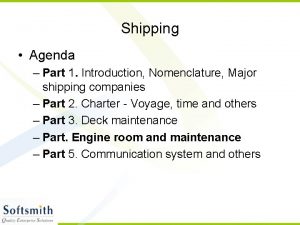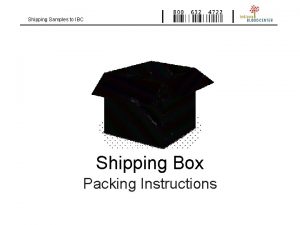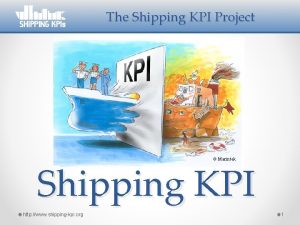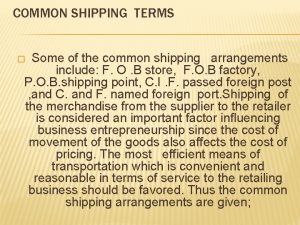VOYAGE ESTIMATE SYSTEM Topic 6 SHIPPING MAINTENANCE Gas


























- Slides: 26

VOYAGE ESTIMATE SYSTEM Topic 6

SHIPPING MAINTENANCE

Gas Tanker-LNG, LPG All gas tankers, be it LNG, LPG fall into one of these categories of containment system and there are three options. 1) The first is to use a ‘self-supporting’ tank system, which sits on a cradle which separates it from the hull. 2) The second is the ‘membrane’ system which moulds the tank to the hull, which provides its strength, with insulation sandwiched between the tank membrane and the hull. The membrane must be able to cope with extreme temperature changes 3) The third option is the ‘prismatic’ system , which is a hybrid, using self-supporting tanks with an inner and outer skin, but tied into the main hull structure. 3

Gas Tanker-LNG, LPG Although the design details vary enormously, the gas is liquefied onshore prior to loading and there are three ways to keep it liquid during transport: a) by pressure; b) by insulating the tanks; or by c) liquefying any gas which boils off and returning it to the cargo tanks (petroleum gas remains liquid at around − 48∞C). � In the case of LNG tankers, there a mix of petroleum gases such as propane, butane and isobutene and chemical gases such as ammonia, ethylene, propylene, butadiene and vinyl chloride. � Most of these gases liquefy at temperatures ranges from − 0. 5∞C to − 50∞C , but some liquefy at much lower temperatures (e. g. ethylene at − 103. 9∞C). Gas tankers must be able to maintain gas at the required temperature during transport. � 4

Gas Tanker-LNG, LPG � Broadly speaking, petrochemical gases are transported in semi-refrigerated or fully pressurized vessels under 20, 000 cubic meters, and LPG and ammonia gases are transported in fully refrigerated vessels, ranging in size from 20, 000 cubic meters to 80, 000 cubic meters, for long-haul, large-volume transportation. � Some semi-refrigerated vessels can carry ethylene (− 104∞C) and ethane (− 82∞C); and in a few cases LNG. 5

Nature of Liquid Cargo In the case of LNG, it is a high-volume commodity and very price-sensitive, so the cost of transport plays a major part in the trade’s economics and ship design. � LNG tankers generally form part of a carefully planned gas supply operation involving a substantial investment in shore-based liquefaction and regasification facilities. � The ship ranged in size up to 153, 000 cubic meters, with a new generation of 270, 000 cubic meters vessels ordered for the long-haul Middle East to USA trades, Malaysia to Japan, and South Korea. � 6

Nature of Liquid Cargo…cont � Natural gas liquefies at − 161. 5∞C, at which temperature it is reduced to 1/630 times its original volume. � LNG tanker is a very sophisticated and expensive vessel, but the broad features are similar to the other tankers such as LPG. � The big difference is the engineering skills, materials and technology required to load, transport and discharge a liquid cargo at a temperature of − 161. 5∞C. 7

Analysis of Net Present Value Business Ventures in O&G Industry 8

Voyage Estimate �a versatile, single interface voyage calculator, able to perform an unlimited number of quick, accurate, simple, complex charter party calculations (or estimates). � The module allows for the calculation and automatic analysis of potential revenues and cost for any combinations of for example vessels, cargoes (or parcels), ports, loads, discharges, terms, freight rates, relets, etc.

Main Charter Party � Voyage charter: ◦ The hire contract for a vessel for one or a specified number of voyages to carry specified cargo at stipulated freight rates (or lumpsums) between designated load and discharge ports and/or regions. ◦ The Vessel Owner will pay port charges and for the operation of the vessel whilst the Charterer pays freight passed on vessel capacity or cargo loaded.

� Time charter: ◦ Two types: A Time Charter (TC) In is the hire of a vessel for a specified period of time, whilst a TC Out Contract handles the letting of a vessel for a particular time period. ◦ Under both, the charterer will decide route and ports, pay a daily hire, all port charges and fuel consumption whilst the Vessel Owner remains in control of the vessel.

Master Data � Performing voyage estimate calculations requires the entry of certain Master Data prerequisites: � Vessel Administration: - is where all user defined vessels and their details are entered, stored and maintained. The vessel data ranges from, for example, both general and specific vessel data to vital speed and bunker consumption details that directly impacts on the accuracy of voyage calculations.


�Vessel type: - Dividing vessels into different types is a method of categorizing vessels. Each vessel type represents a particular form of vessel decided by size, (for example PANAMAX), or usage (for example MULTI PURPOSE). - Each type is identified by a unique code and name and linked to a Vessel Category, (used to differentiate how a vessel appears and is calculated for, examples thereof are: Bulk, Chemical, Container, etc. ).

� The vessel type information is used throughout the system, as many modules will behave and function according to vessel type, (or more specifically, according to Vessel Category). � Example: If a container vessel has the correct type and category the Container tab will be visible when entering the vessel in the Vessel Administration module.


� Business Partners: -All information about a company's business partners are held and maintained in the Business Partner module, for example name, contact details, bank accounts, business unit, etc. -All business partners have a business partner type (or role) and grouped according to type, i. e. Agent, Broker, Charterer, Supplier, etc. -Each business partner is identified by a unique code, name and sort name and can be linked to bank accounts.


� Commodity : -Commodities are articles of commerce or quantity of goods of economic wealth, often used as inputs in the production of other goods or services. -They are bulk goods and raw materials and can be divided into three types: soft-, hardand energy commodities.

� Soft commodities are goods that are grown, for example agricultural products (grains, cotton, coffee beans, soybeans, sugar, etc. ), livestock and salt. � hard commodities are those extracted through mining, such as metals and minerals. � Energy commodities include electricity, natural gas, coal, petroleum and crude oil.


� Laytime Terms: -The Laytime Terms module lists all predefined, (i. e. "fixed", comes with the system. -in charter parties deciding how laytime is calculated and accounted for. -Each term is defined by a unique code and name. The code consists of a short sequence of letters for quick identification of a particular terms.

example "X" can indicate SHEX (Sundays Holidays Excluded). The unique name is either spelled out or an abbreviation and is used to display the terms in. � For


� Variuos Text: -The Various Text module allows users to enter various cost and revenue items that are not fixed items in Dataloy VMS. -Each item is identified by a unique code and name and represents a particular type of cost or revenue that can be included in several sections of a voyage calculation. The entered unfixed items, (for example War Risk Insurance) �

 Dataloy vms
Dataloy vms Voyage voyage
Voyage voyage Le voyage chanson
Le voyage chanson Tramp shipping and liner shipping
Tramp shipping and liner shipping Painted paragraph strategy
Painted paragraph strategy Narrow
Narrow Institutional brokers estimate system
Institutional brokers estimate system Moreno valley water
Moreno valley water Types of tps
Types of tps Voyage estimating decision support system
Voyage estimating decision support system Execution in voyage planning
Execution in voyage planning Voyage estimating decision support system
Voyage estimating decision support system Voyage estimating decision support system
Voyage estimating decision support system Types of information systems
Types of information systems Imo gisis
Imo gisis Ideal gas vs perfect gas
Ideal gas vs perfect gas An ideal gas is an imaginary gas
An ideal gas is an imaginary gas Differences between ideal gas and real gas
Differences between ideal gas and real gas Sutherland's law
Sutherland's law Conclusion
Conclusion Gas leaked in bhopal gas tragedy
Gas leaked in bhopal gas tragedy Gas reale e gas ideale
Gas reale e gas ideale Flue gas desulfurisation gas filter
Flue gas desulfurisation gas filter Poisonous gas leaked in bhopal gas tragedy
Poisonous gas leaked in bhopal gas tragedy Difference between ideal gas and real gas
Difference between ideal gas and real gas Contoh soal kinetika kimia orde 1
Contoh soal kinetika kimia orde 1 Gas exchange key events in gas exchange
Gas exchange key events in gas exchange
